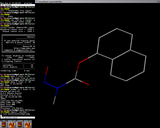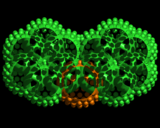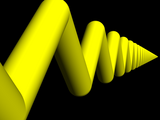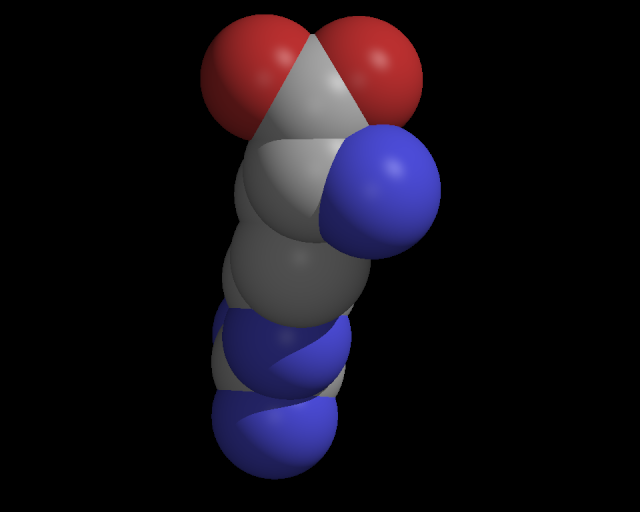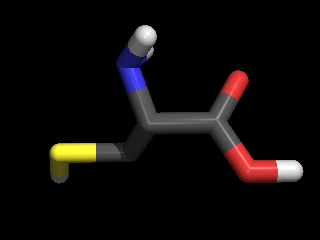
Welcome to Molecules@gnu-darwin.org
Molecule News and Molecule of the Day
This site is under constant construction. Try our new custom search widget!Loading
The molecule of the day is: Apigenin Apigenin is probably the most inexpensive and widely available flavonoid, because it is present in more than 1:10 gram for gram quantities in common parsley flakes in the form of apin. Apigenin is the resveratrol-like flavone, with similar properties and healthful benefits. Although apigenin has not yet received as much attention as resveratrol, the research that does exist is very promising, and apigenin has consistently performed well in comparitive studies thus far. This is not all. Apigenin is in the group of flavonoids that have a paradoxical anti-diarrheal property. Apigenin acts by blockading the cystic fibrosis transmembrane conductance regulator (CFTR) chloride channel, so that water is conserved in the body and not lost in the intestine. Diarrhea and ancillary effects such as dehydration can be a scourge in many of the poor areas of the world, producing many fatalities, especially among young children. Parsley flakes have now been proposed as an addition to the anti-diarrhea regimen, and a sophisticated molecular agent is now inexpensively and readily available to help solve a major problem in the world. Finally, parsley is simply a delightful and tastey spice. More information, including recipes, is available in the blog. Apigenin related molecules gallery and structural archive SMILES: O1C(=CC(=O)c2c1cc(O)cc2O)c3ccc(O)cc3 other names: 1151-98-0 Apigeninidin C08574 28441-98-7 6,8''-Biapigenin Agathisflavone C10017 1617-53-4 3',8''-Biapigenin Amentoflavone C10018 5128-44-9 Apigenin 7,4'-dimethyl ether Apigenin dimethylether C10019 Apigenin 7-(6''-malonylglucoside) Apigenin 7-O-(6-malonyl-beta-D-glucoside) C10020 3952-18-9 8,8''-Biapigenin C10034 Cupressuflavone 437-64-9 Apigenin 7-methyl ether C10046 Genkwanin 41440-05-5 8-Hydroxyapigenin C10097 Isoscutellarein 3',6''-Biapigenin 49620-13-5 C10179 Robustaflavone 529-53-3 6-Hydroxyapigenin C10184 Isocarthamidin Scutellarein 23666-13-9 5,7,4'-Trihydroxyflavone-6,8-di-C-glucoside Apigenin-6,8-di-C-glycoside C10195 Vicenin-2 3681-93-4 Apigenin 8-C-glucoside C01460 Vitexin 4',5,7-Trihydroxyflavone 5,7,4'-Trihydroxyflavone 520-36-5 Apigenin C01477 29702-25-8 38953-85-4 6-C-Glucosylapigenin Apigenin 6-C-glucoside Apigenin-6-C-glucoside C01714 Isovitexin Saponaretin 578-74-5 7-(beta-D-Glucopyranosyloxy)-5-hydroxy-2-(4-hydroxyphenyl)-4H-1-benzop yran-4-one 7-O-beta-D-Glucosyl-5,7,4'-trihydroxyflavone Apigenin 7-O-beta-D-glucoside Apigenin 7-O-glucoside Apigetrin C04608 Cosmetin Cosmosiin 26544-34-3 7-O-(beta-D-Apiofuranosyl-1,2-beta-D-glucosyl)-5,7,4'-trihydroxyflavon e 7-[(2-O-D-Apio-beta-D-furanosyl-beta-D-glucopyranosyl)oxy]-5-hydroxy-2 -(4-hydroxy-phenyl)-4H-1-benzopyran-4-one Apigenin 7-O-[beta-D-apiosyl-(1- 3-Methoxyapigenin C05902 4'-Methoxyapigenin 480-44-4 4H-1-Benzopyran-4-one, 5,7-dihydroxy-2-(4-methoxyphenyl)- 5,7-Dihydroxy-4'-methoxyflavone 5,7-Dioxy-4'-methoxyflavone ACAETIN Acacetin Acacetine Akatsetin Apigenin 4'-dimethyl ether Apigenin 4'-methyl ether Apisenin 4'-methyl ether Buddleoflavonol Flavone, 5,7-dihydroxy-4'-methoxy- Linarigenin Linarisenin NSC76061 WLN: T66 BO EVJ CR DO1& GQ IQ 4',5,7-Trihydroxyflavone 4H-1-Benzopyran-4-one, 5,7-dihydroxy-2-(4-hydroxyphenyl)- 520-36-5 Apigenin Apigenine Apigenol C.I. Natural Yellow 1 Chamomile Flavone, 4',5,7-trihydroxy- NSC83244 Spigenin 4'-Methoxyapigenin 480-44-4 4H-1-BENZOPYRAN-4-ONE, 5,7-DIHYDROXY-2-(4-METHOXYPHENYL)- 5,7-Dihydroxy-2-(4-methoxyphenyl)-4-benzopyrone 5,7-Dihydroxy-4'-methoxyflavone 5,7-Dioxy-4'-methoxyflavone 5-18-04-00575 (Beilstein Handbook Reference) Acacetin Acacetine Akatsetin Apigenin 4'-dimethyl ether Apigenin 4'-methyl ether Apisenin 4'-methyl ether BRN 0277879 Buddleoflavonol EINECS 207-552-3 Flavone, 5,7-dihydroxy-4'-methoxy- Flavone, 5,7-dihydroxy-4'-methoxy- (8CI) Linarigenin Linarisenin NSC 76061 3'-Methoxyapigenin 3'-O-Methyluteolin 491-71-4 4H-1-Benzopyran-4-one, 5,7-dihydroxy-2-(4-hydroxy-3-methoxyphenyl)- 5,7-Dihydroxy-2-(4-hydroxy-3-methoxyphenyl)-4-benzopyrone 5,7-Dihydroxy-2-(4-hydroxy-3-methoxyphenyl)-4H-1-benzopyran-4-one 5-18-05-00296 (Beilstein Handbook Reference) BRN 0295004 Chryseriol Chrysoeriol EINECS 207-742-6 FLAVONE, 4',5,7-TRIHYDROXY-3'-METHOXY- Luteolin 3'-methyl ether 2-(p-Hydroxyphenyl)-5,7-dihydroxychromone 4',5,7-Trihydroxyflavone 461015-54-3 4H-1-Benzopyran-4-one, 5,7-dihydroxy-2-(4-hydroxyphenyl)- (9CI) 5,7-Dihydroxy-2-(4-hydroxyphenyl)-4-benzopyrone 5-18-04-00574 (Beilstein Handbook Reference) 520-36-5 Apigenin Apigenine Apigenol BRN 0262620 C.I. Natural Yellow 1 CCRIS 3789 Chamomile EINECS 208-292-3 FLAVONE, 4',5,7-TRIHYDROXY- NSC 83244 Pelargidenon 1449 Spigenin UCCF 031 Versulin 3316-46-9 4',5,7-Triacetoxy flavone 4H-1-Benzopyran-4-one, 5,7-bis(acetyloxy)-2-(4-acetyloxy)phenyl- Apigenin triacetate FLAVONE, 4',5,7-TRIHYDROXY-, TRIACETATE Triacetyl apigenin 4H-1-Benzopyran-4-one, 7-(beta-D-glucopyranosyloxy)-5-hydroxy-2-(4-hydroxyphenyl)- (9CI) 578-74-5 7-(beta-D-Glucopyranosyloxy)-5-hydroxy-2-(4-hydroxyphenyl)-4H-1-benzop yran-4-one 7-O-(beta-D-Glucosyl)apigenin APIGENIN, 7-B-D-GLYCOPYRANOSIDE Apigenin 7-O-beta-D-glucopyranoside Apigenin 7-O-beta-D-glucoside Apigenin, 7-beta-D-glucopyranoside Apigetrin COSMOSIIN Cosmosiin (8CI) Cosmosiine Cosmosioside EINECS 209-430-5 NSC 407303 1447-88-7 4',5,7-Trihydroxy-6-methoxyflavone 4H-1-Benzopyran-4-one, 5, 7-dihydroxy-2-(4-hydroxyphenyl)-6-methoxy- 5,7-Dihydroxy-2-(4-hydroxyphenyl)-6-methoxy-4H-chromen-4-one 6-O-Methylapigenin AIDS-126680 AIDS126680 Dinatin Flavone, 4',5,7-trihydroxy-6-methoxy- Hispidulin NSC122415 4',7-Dimethylapigenin 4H-1-Benzopyran-4-one, 5-hydroxy-7-methoxy-2-(4-methoxyphenyl)- 5-Hydroxy-4',7-dimethoxyflavone 5-Hydroxy-7,4'-dimethoxyflavone 5128-44-9 Apigenin 4',7-dimethyl ether Apigenin 7,4'-dimethyl ether FLAVONE,5-HYDROXY-4-7-DIMETHOXY Flavone, 5-hydroxy-4',7-dimethoxy- Genkwanin 4'-methyl ether NSC94547 1447-88-7 4',5,7-Trihydroxy-6-methoxyflavone 4H-1-Benzopyran-4-one, 5,7-dihydroxy-2-(4-hydroxyphenyl)-6-methoxy- 6-O-Methylapigenin Dinatin Flavone, 4',5,7-trihydroxy-6-methoxy- HISPIDULIN NSC122415 4H-1-Benzopyran-4-one, 7-(.beta.-D-glucopyranosyloxy)-5-hydroxy-2-(4-hydroxyphenyl)- 578-74-5 7-O-(.beta.-D-Glucosyl)apigenin APIGENIN, 7-B-D-GLYCOPYRANOSIDE Apigenin 7-O-.beta.-D-glucopyranoside Apigenin 7-O-.beta.-D-glucoside Apigenin 7-O-glucoside Apigenin, 7-.beta.-D-glucopyranoside Apigetrin COSMOSIIN Cosmetin Cosmosiine Cosmosioside NSC407303 1151-98-0 APIGENINIDIN NSC60167 Apigenin 7-O-neohesperidoside C12627 Rhoifolin Rhoifoloside 5,7-Dihydroxy-2-(4-hydroxyphenyl)-4H-1-benzopyran-4-one 520-36-5 AIDS-001401 AIDS001401 Apigenin ND-9076 NSC83244 Versulin 4'-Methoxyapigenin 480-44-4 4H-1-Benzopyran-4-one, 5,7-dihydroxy-2-(4-methoxyphenyl)- AIDS-014771 AIDS014771 Acacetin Acacetine Acaceztin Linarigenin Linarisenin NSC76061 AIDS-046039 AIDS046039 C3-C3''-biapigenin hexamethyether [3,3'-Bi-4H-1-benzopyran]-4,4'-dione, 5,5',7,7'-tetramethoxy-2,2'-bis(4-methoxyphenyl)- html/00600001_00625000/620996 5-Hydroxy-2-(4-hydroxyphenyl)-7-(4,5,6-trihydroxy-3-((4,5,6-trihydroxy -3-methyl(2-oxanyloxy))methyl)(2-oxanyloxy))-4H-chromen-4-one AIDS-051936 AIDS051936 Apigenin-7-O-neohesperidoside 6-2''-Biapigenin hexamethylether 6-[2-(5,7-Dimethoxy-4-oxochromen-2-yl)-5-methoxyphenyl]-5,7-dimethoxy- 2-(4-methoxyphenyl)chromen-4-one AIDS-110721 AIDS110721 4',7-Dimethylapigenin 4H-1-Benzopyran-4-one, 5-hydroxy-7-methoxy-2-(4-methoxyphenyl)- (9CI) 5-Hydroxy-7-methoxy-2-(4-methoxyphenyl)-4-benzopyrone 5128-44-9 Apigenin 4',7-dimethyl ether Apigenin 7,4'-dimethyl ether Apigenin dimethylether EINECS 225-867-4 Flavone, 5-hydroxy-4',7-dimethoxy- (8CI) Flavone, 5-hydroxy-4,7-dimethoxy- Genkwanin 4'-methyl ether NSC 94547 4',5,7-Trimethoxyflavone 4',5,7-Trimethyl-apigenin 4H-1-Benzenopyran-4-one, 5,7-dimethoxy-2-(4-methoxyphenyl)- 5,7,4'-Trimethylapigenin 5,7-Dimethoxy-2-(4-methoxyphenyl)-4H-1-benzenopyran-4-one 5631-70-9 3681-93-4 4H-1-Benzopyran-4-one, 5,7-dihydroxy-8-beta-D-glucopyranosyl-2-(4-hydroxyphenyl)- 4H-1-Benzopyran-4-one, 8-beta-D-glucopyranosyl-5,7-dihydroxy-2-(4-hydroxyphenyl)- 521-33-5 8-beta-D-Glucopyranosyl-5,7-dihydroxy-2-(4-hydroxyphenyl)-4H-1-benzopy ran-4-one 8-beta-D-Glucopyranosyl-apigenin Apigenin 8-C-glucoside EINECS 222-963-8 Flavone, 8-D-glucosyl-4',5,7-trihydroxy- Vitexin 4H-1-Benzopyran-4-one, 6,8-di-beta-D-galactopyranosyl-5,7-dihydroxy-2-(4-hydroxyphenyl)- 6,8-Di-C-galactopyranosyl-apigenin 82043-11-6 Apigenin 6,8-digalactoside 7-MAG 86546-87-4 Apigenin 7-O-(6-O-malonylglucoside) Malonyl apigenin 7-O-glucoside Propanedioic acid, 6'-ester with 7-(beta-D-glucopyranosyloxy)-5-hydroxy-2-(4-hydroxyphenyl)-4H-1-benzop yran-4-one 105815-90-5 4H-1-Benzopyran-4-one, 5-hydroxy-2-(4-hydroxyphenyl)-7-((6-O-(3-(4-hydroxyphenyl)-1-oxo-2-pro penyl)-beta-D-glucopyranosyl)oxy)-, (E)- Acbglu Apigenin-7-O-(6''-O-4-coumaroyl)-beta-glucopyranoside 119738-57-7 Apigenin-7-O-glucuronopyranosyl(1-2)-glucuronopyranoside Clerodendrin beta-D-Glucopyranosiduronic acid, 5-hydroxy-2-(4-hydroxyphenyl)-4-oxo-4H-1-benzopyran-7-yl 2-O-beta-D-glucopyranuronosyl- 1-Benzopyrylium, 5,7-dihydroxy-2-(4-hydroxyphenyl)-, chloride 1151-98-0 5,7-Dihydroxy-2-(4-hydroxyphenyl)-1-benzopyrylium chloride Apigeninidin NSC 60167 38953-85-4 4H-1-Benzopyran-4-one, 6-beta-D-glucopyranosyl-5,7-dihydroxy-2-(4-hydroxyphenyl)- (VAN) 6-Glucosylapigenin 61383-34-4 61838-34-4 Isovitexin 107911-03-5 4H-1-Benzopyran-4-one, 6,8-di-beta-D-arabinopyranosyl-5,7-dihydroxy-2-(4-hydroxyphenyl)- 6,8-Di-C-beta-D-arabinopyranosyl apigenin |
  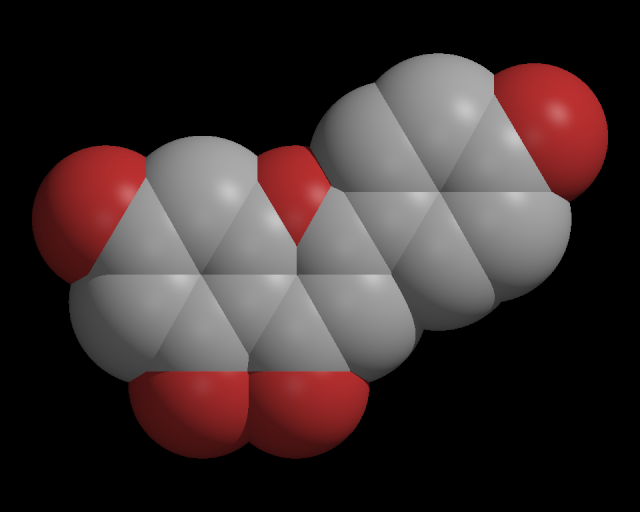 pdb file:584548.pdb directory:584548 CAS: 208-292-3
sirius yellow cross-eyed 3D
|
Molecule News
updated Sun Dec 27 17:18:25 EST 2009For those who are following the activism aspect of the Molecules site, I thought that you might be interested in a little pre-history as it were. Prior to the founding of the Molecules site, the activism first hatched under the GNU-Darwin umbrella, and the fundamental idea of molecules activism was invented. Initially, it was concerned primarily with resveratrol and other caloric restriction memetics, but it was clearly bound to expand from there. You can read some of the early material in the GNU-Darwin Posts regarding resveratrol and calorie restriction. As was previously mentioned, the ideas were formally developed in the FOSS, Science, and Public activism essay, and it was even put forth as a war protest in the so-called bootstrapping essay. As the Molecules site developed, it became clear that additional adjunct activities were required in order to push the activism harder. One of these adjuncts was created on the Vitacost website, where it is easy to provide directed links to crucial molecules for those who want to obtain them for themselves. Moreover, the activism ideas continue to evolve there in blog format. Check it out: Michael L. Love proclus Blog on Vitacost.
updated Wed Dec 9 16:22:35 EST 2009
A new Google search widget was added to the top of the main page, and search results are now displayed inside the page. I like it, but I am definitely interested in the opinions of our users, so feel free to write in. For those that prefer it, we will be leaving the old widget in the left sidebar for the foreseeable.
In other Google-related site news, the search function warning has been removed, because Google appears to have indexed the site rather thoroughly, and updates are happening regularly as well. It appears that Google may read our site news ;-}, and they are now spidering more strategically at any rate. Moreover, given their spidering rate, it can be expected that they could have spidered the entire site in the time that it has been on line.
The molecules site is an SEO enigma. Top key words are numerically a small component of our search volume, accounting for hundreds of searches in the last year or so. Obscure single searches account for thousands. This disparity is expected to grow as we grow the archive and add structured 3D compounds. I am impressed that our users are more concerned about the less commonplace, a compliment I hope.
updated Tue Dec 1 13:38:54 EST 2009
Although the main MOD has not received an update for some time, ample work has been going on behind the scenes, and we have developed a number of fine galleries, which rise almost to MOD status. Under the aegis of The GNU-Darwin Distribution, the Molecules site also maintains an activist component to its mission. The latest example of these two factors in action is the beta sitosterol gallery, which again demonstrates how we can publish and link on a particular molecule of interest. If you are interested in seeing more of this kind of work, please feel free to write in and let us know. Activist work is likely to be pro bono, and the premise is simple; to publish and promote prior art and public knowledge of molecules, which can have an impact on people's access to inexpensive medicine, beneficial supplements, and other important uses, outside of corporate channeled biased knowledge and their monopolistic price structure. The best summary of the over-arching principles in play is the FOSS, Science, and Public activism essay.
updated Thu Nov 26 11:52:24 EST 2009
|
If you would like to learn more about the Molecules site founder, you can visit some of the following links.
|
updated Fri Nov 6 15:33:43 EST 2009
Many of our site visitors will be familiar with the PyMOL software, which is used to produce many of the best molecular graphics images on this site. We have learned that the author and creator of PyMOL, Warren Delano, has passed on at age 37. Warren was a friend, who will be missed and remembered, but his many contributions live on. The family has created a blog where those who have memories of Warren can share them.
updated Thu Oct 22 15:03:10 EDT 2009
The profile of the archive is growing and spreading on the web, and we currently have about 131 external links, with more certainly on the way. Some of them are featured in our sidebar. If you have a great page that links to the Molecules site, be sure and let us know! Our ad revenues only defray in part the cost of operating the site, and we are looking for more opportunities. If you would like us to provide pertinent links or publish on a particular molecule, it is certainly something that we can consider. Here is an example of the kinds of things that we can do. Email us!
updated Thu Oct 15 20:36:29 EDT 2009
tip: All of our molecule image files are contained in their respective directories, with the pdb, sdf and other related files and information. If you pull an image up from Google Image, simply delete the image name from the URL to see the molecule directory information. That is what I do. More MOD galleries have been generated in order to answer demand and take some load off of the main gallery page, which contains a vast number of images. It can definitely be slow loading. Some of the MOD gallaries are also quite large, so that this tip applies to some of them as well. Plans are afoot to deal with some of the large slow loading pages.
The top page has only received occasional updates in the past year, due the fact that I have been very busy elsewhere. One of the things that keeps me busy is the site generation code, which is a marvellous research tool. All of the code is available in the infrastructure link in the left sidebar. Google seems to find the infrastructure more interesting than the rest of the site! Over the course of the past year, 100 MOD galleries have been generated, and many thousands of molecule directories have been generated or refreshed. Now that thousands of files have been indexed, the Google search tool works nicely, although the site obviously contains orders of magnitude more files than Google has yet been able to index, in spite of their impressive constant crawling.
Google Webmaster Tools reports that the number of links on the site is "extremely high". With a tiny number of exceptions, all of the pages are generated by machine, so that it is not hard to imagine the situation will improve vastly in the future. The links are clustered together on each molecule page. We are also working on an alphanumeric index, which already contains a large number of links by name to molecule directories, but like so much of the site, it is intended for human eyes. It is only full of links. We have transitioned to a new server, which has improved stability, and it appears to be faster. Nonetheless, some instability in our network connection has appeared since the time of the upgrade, so that there are occasionally several second delays in loading. I haven't figured out why yet.
updated Wed Sep 17 23:56:32 EDT 2008
Added Molscript graphics and MOD desktop image to the right sidebar. The theme is infinite carbon chain. The code is in infrastructure. The other main molecular graphics programs in use at this time are RasMol, Rester3D, PyMOL, and PovChem. The viewer is xzgv, and ImageMagick for touch up; mainly mogrify and convert. Please feel free to send any questions along.
updated Thu Sep 11 22:33:51 EDT 2008
We continue to get encouragment to provide coordinate files with improved geometry, although this is a computationally intensive task which is down the road still. Meanwhile, a few supurb 3-dimensional structures are already found in the archive, and two of them have been featured in the right sidebar today. If you rummage around in the MOD galleries, you are likely to find more 3D coordinate files, as well as some very interesting 2D representations! In our opinion, many of the most interesting molecules have planar geometry, so that the current files are quite useful. In due course, we plan to provide a comprehensive collection of coordinate files with good stereochemical geometry, all in the selfsame spirit of free and open source software and public access. We welcome any and all input.
updated Wed Sep 10 20:28:49 EDT 2008
Our new directory style was featured in a the right sidebar of the Jasmone MOD page today. Just click the directory link from the top page or in any of the recent galleries to view this new feature. These pages typically include links to the source databases, which often have chemical diagrams or useful additional information about the molecules. A smiley code is currently featured at the bottom of each page. Smile.
updated Thu Sep 4 22:28:57 EDT 2008
Added quick navigation links to the left side bar. The site has reached 111 GB, and a massive backup is underway. We are still just getting started.
updated Thu Sep 4 13:30:20 EDT 2008
Added developer links to the left side bar.
updated Wed Sep 3 12:05:13 EDT 2008
I have automated the process to make molecule galleries, which I am finding very useful to my research, so I thought that I would share the opportunity and take requests. It is quick and easy. I did a bisphenol search today, and as I expected, the search turned up a few stilbenes, which is the same molecular family as resveratrol. Strikingly, Bisphenol A is a noted teratogen, which shows that care must be taken when using such molecules during pregnancy, nursing, and development. Here is a link to the bisphenol gallery.
http://molecules.gnu-darwin.org/mod/Bisphenol-more.html
If you would find it useful, I am definitely interested in taking requests for molecule galleries. Just send me the name of your favorite molecule. As you may be able to tell, we have access for galleries to about 1% or 0.5 million structures, in the total archive thus far, but it is already quite useful. The automated jobs are underway to fill in the rest. The next milestone is the capability to index and make galleries for the remaining millions of molecules for which we have pdb files already, which would be 5-10% complete. Any comments or suggestions are also welcome.
updated Tue Sep 2 14:10:15 EDT 2008
A terminal screenshot has been added to the right sidebar, in order to show the kind of code that is being used to generate the Molecules directory indices. All inquiries and suggestions are welcome.
updated Fri Aug 29 14:39:14 EDT 2008
Reaction to our website has been quite positive and encouraging, but people are anxious to see structures with improved stereochemistry. We have received many suggestions about how to make that happen faster. For the time being, we are experiencing the best structure viewing results with RasMOL. Name extraction and structure file linking jobs are underway, which is an indication that we are still in a preliminary phase. Google spiders more almost everyday, and past experience indicates that the search capability will become very useful indeed! Here is some secret mumbo jumbo. I'm afraid that my Japanese or Korean is broken at best ;-}. Enjoy!
updated Wed Aug 27 21:38:32 EDT 2008
An RSS News Feed has been added to the right side bar.
updated Tue Aug 26 19:27:29 EDT 2008
Several new indices have been added to our sidebar, notably; current index by name, and gallery by name. These are large indices, but also vastly incomplete, and work is underway to improve them. A list of bloggers who have mentioned the site, with links in their blogs, is now in the front sidebar, although only one is known thus far. Due to the vastness of the scale, many of these things will be divided out and buried a little deeper eventually, but they can be showcased now, and they are a good survey.
updated Tue Aug 19 19:45:09 EDT 2008
Some facts: The Molecules website contains more than 4 million small molecule structure files in pdb format, and molecular graphics representations. About 50 million molecules are still in the pipe, and they are expected to appear here over the course of the next few weeks and months. The pdb format is readable by common FOSS molecule viewer software, such as RasMol and PyMOL. In due course, we plan to provide high quality structures via energy minimization refinement, and additional resources.
Molecules@gnu-darwin.org is founded in the spirit of free software, open source, and public access. It is hoped that access to these files will be a wonderful community resource for science education, research, and entertainment as well. We are looking for investment, funding, or sponsorship in order to expedite and expand this work, and lead the field, with an eye towards an advanced, complete, synthetic, structural, and informatical bioorganome. Meanwhile, the site is already an exceptional lab resource, and molecular catalog, providing the means and building blocks towards additional novel structures. We aim to be the best.
The structural biology, protein crystallography, and molecular graphics talent that is building the Molecules archive is available to work for you in a contract or consulting arrangement. Wide-ranging expertise is available. Molecules@gnu-darwin.org is built entirely with FOSS, free and open source software, GNU-Darwin OS, and it is under the aegis of The GNU-Darwin Distribution. Here is a link to the Distribution résumé. Our founder is an X-ray laboratory admin for the Department of Biophysics and Biophysical Chemistry of Johns Hopkins University School of Medicine. You can also read his CV. We would like to build a community around this website, and we are looking for volunteers and collaborators to help. Regarding any aspect of the work of this site, please feel free to contact us, molecules@gnu-darwin.org, with gdmolecules in the subject line. Cheers!




